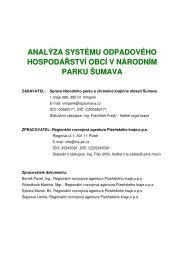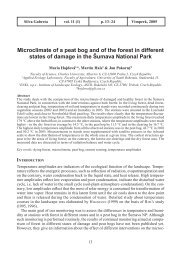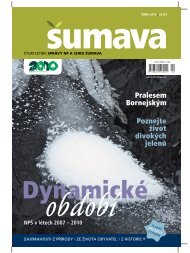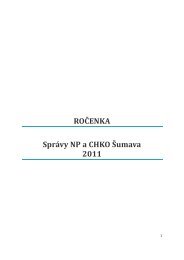Algae, Cyanobacteria and Chytridiales of Černé Lake in the ...
Algae, Cyanobacteria and Chytridiales of Černé Lake in the ...
Algae, Cyanobacteria and Chytridiales of Černé Lake in the ...
You also want an ePaper? Increase the reach of your titles
YUMPU automatically turns print PDFs into web optimized ePapers that Google loves.
evaluations because <strong>the</strong>y are not directly <strong>in</strong>fluenced by big towns or <strong>in</strong>dustrial areas <strong>and</strong>,<br />
consequently, are controlled by <strong>the</strong> mean changes <strong>of</strong> <strong>the</strong> general environment (MORALES-<br />
-BAQUERO et al. 1992, MOSELLO et al. 1992, STRAŠKRABOVÁ 1995, SOMMARUGA & PSENNER 2001,<br />
GRABHERR et al. 2005). <strong>Lake</strong>s with a comparably long history <strong>of</strong> monitor<strong>in</strong>g, to that <strong>of</strong> <strong>Černé</strong><br />
<strong>Lake</strong>, are not common, e.g. <strong>Lake</strong> Erie has been phycologically <strong>in</strong>vestigated s<strong>in</strong>ce 1898 (DOW-<br />
NING 1970). WEISER (1947) compiled <strong>the</strong> history <strong>of</strong> <strong>the</strong> explorations <strong>of</strong> <strong>Černé</strong> <strong>Lake</strong> <strong>and</strong> deduced<br />
<strong>the</strong> succession <strong>of</strong> zooplankton <strong>and</strong> limnological classification <strong>of</strong> <strong>the</strong> lake. He stated that<br />
<strong>the</strong> lake was oligotrophic, at least for <strong>the</strong> past half century. The present sharp decl<strong>in</strong>e <strong>of</strong> air<br />
pollution, follow<strong>in</strong>g its maximum <strong>in</strong> 1980, gave us a unique chance to study <strong>the</strong> reaction <strong>of</strong><br />
<strong>the</strong> lake to acidification <strong>and</strong> its subsequent recovery; utiliz<strong>in</strong>g <strong>the</strong> monitor<strong>in</strong>g background <strong>of</strong><br />
over a century (VRBA et al. 2003).<br />
Phytoplankton research, unfortunately, had been limited by <strong>the</strong> technique <strong>of</strong> concentration.<br />
In <strong>the</strong> period <strong>of</strong> FRIČ & VÁVRA (1897), phytoplakton were not evaluated, STEINICH (<strong>in</strong><br />
FRIČ & VÁVRA 1897) worked-up Bacillariophyceae from mud, collected from a depth <strong>of</strong><br />
20–35 m, <strong>and</strong> HANSGIRG (<strong>in</strong> FRIČ & VÁVRA 1897) determ<strong>in</strong>ed littoral algae from periphyton<br />
<strong>and</strong> stones. B. FOTT (1936, 1938, unpubl. data) was <strong>the</strong> first who <strong>in</strong>troduced centrifugation<br />
<strong>and</strong> <strong>the</strong> Utermöhl’s chamber; <strong>and</strong> <strong>the</strong> author <strong>of</strong> this paper also <strong>in</strong>troduced membrane filtration,<br />
for <strong>the</strong> concentration <strong>of</strong> phytoplankton. This, unfortunately, limits <strong>the</strong> comparison <strong>of</strong><br />
planktonic algae now <strong>and</strong> <strong>of</strong> century ago. FOTT (1937, 1938) described 3 new species from<br />
<strong>Černé</strong> <strong>Lake</strong> to <strong>the</strong> science (Bitrichia ollula, syn. Diceras ollula; Katod<strong>in</strong>ium bohemicum syn.<br />
Gymnod<strong>in</strong>ium bohemicum, <strong>and</strong> Katod<strong>in</strong>ium planum syn. Massartia plana), but o<strong>the</strong>r algae,<br />
lists <strong>of</strong> species, <strong>and</strong> vertical stratification <strong>and</strong> draw<strong>in</strong>gs are only from his unpublished field<br />
notebook (Fig. 1; all Figs except one are placed at <strong>the</strong> end <strong>of</strong> <strong>the</strong> contribution). ROSA (1941)<br />
found <strong>the</strong>re 11 new species for Bohemia. NEDBALOVÁ & VRTIŠKA (2000) found 24 species <strong>of</strong><br />
phytoplankton <strong>in</strong> <strong>the</strong> lake.<br />
Species richness is also dependent upon progress <strong>in</strong> taxonomy, e.g., STEINICH <strong>in</strong> FRIČ &<br />
VÁVRA (1897) determ<strong>in</strong>ed 28 taxa <strong>in</strong> <strong>the</strong> lake, ŘEHÁKOVÁ <strong>in</strong> SCHMIDT et al. (1993) determ<strong>in</strong>ed<br />
from a core 157 species <strong>of</strong> Bacillariophyceae.<br />
The first hydrochemical analysis was carried out by HANNAMANN <strong>in</strong> 1895 (<strong>in</strong> FRIČ & VÁVRA<br />
1897), next by JÍROVEC & JÍROVCOVÁ (1937); followed by <strong>the</strong> historical development <strong>of</strong> <strong>the</strong> lake<br />
be<strong>in</strong>g compiled by SCHMIDT et al. (1993), VESELÝ (1994, 1996), VRBA et al. (1996, 2000).<br />
Several sediment cores were taken from <strong>Černé</strong> <strong>Lake</strong>. This technique allows for <strong>the</strong> reconstruction<br />
<strong>of</strong> <strong>the</strong> history <strong>of</strong> <strong>the</strong> lake s<strong>in</strong>ce its orig<strong>in</strong>, unfortunately with some limitations: only<br />
organisms with solid rema<strong>in</strong>s are preserved, such as pollen gra<strong>in</strong>s, Cladocera, Bacillariophyceae,<br />
some Chlorococcales, scales <strong>of</strong> Chrysophyta, some D<strong>in</strong>ophyceae, Stomatocysts,<br />
etc. (SCHMIDT et al. 1993, BŘÍZOVÁ 1996, VESELÝ 1998).<br />
The aim <strong>of</strong> this study is to prepare <strong>the</strong> list <strong>of</strong> species <strong>of</strong> algae for quantitative evaluation<br />
<strong>of</strong> phytoplankton, for <strong>the</strong> evaluation <strong>of</strong> algae <strong>in</strong> cores <strong>and</strong> preserved samples; <strong>and</strong> for evaluations<br />
<strong>of</strong> long-term monitor<strong>in</strong>g <strong>of</strong> <strong>the</strong> environment. Stress should also be placed upon detailed<br />
documentation, <strong>in</strong>clud<strong>in</strong>g common species, which are usually overlooked.<br />
MATERIAL AND METHODS<br />
Site description<br />
<strong>Černé</strong> <strong>Lake</strong> is situated 1007 m a.s.l., 49°11' N <strong>and</strong> 13°11' E, <strong>in</strong> <strong>the</strong> corrie exposed towards<br />
south-east. The catchment (1.24 km2 ) consists <strong>of</strong> mica-schist (muscovitic gneisses) with<br />
quartzite <strong>in</strong>trusions (VESELÝ 1994). The dam on <strong>the</strong> lake is <strong>of</strong> mora<strong>in</strong>e orig<strong>in</strong>, but it has been<br />
fur<strong>the</strong>r piled-up <strong>and</strong> adapted. There is an artificial outlet for <strong>the</strong> control <strong>of</strong> <strong>the</strong> water level<br />
2


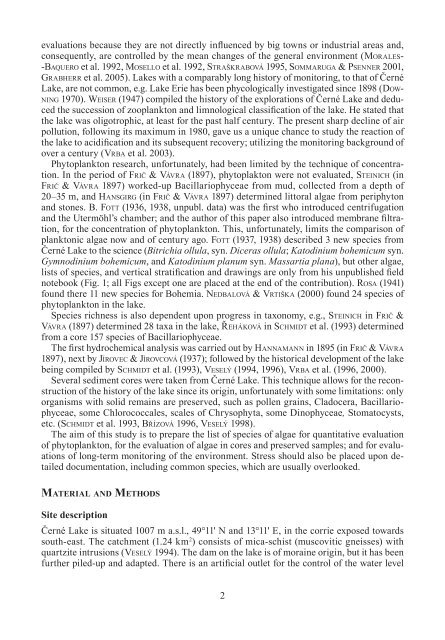
![Zima 2008 [4MB] - Národní park Šumava](https://img.yumpu.com/21236024/1/184x260/zima-2008-4mb-narodni-park-sumava.jpg?quality=85)
